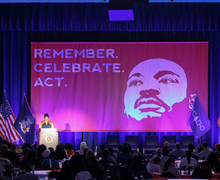Opinion: Traveling around Syracuse isn’t as easy as it should be
Madison Denis | Contributing Illustrator
The cost of transportation around a university which claims to be walkable separates many students at SU, our columnist writes. As result, the pre-existing socioeconomic divide on campus is widened.
Get the latest Syracuse news delivered right to your inbox.
Subscribe to our newsletter here.
Images of the Hall of Languages and Einhorn Walkway from above depict Syracuse University’s walkability to be above par. But in reality, certain aspects of SU’s campus make traveling difficult for students. Aside from the chilling temperatures, the hilly, isolated nature of SU can often be tougher to navigate than stunning campus pictures illustrate.
While your tour guide might’ve called this school walkable, their reassurances are certainly debatable.
As an international university, many SU students fly from home to school. When they’re finally out of the dorms and allowed to bring a vehicle, the school doesn’t offer much convenient, let alone free, parking. Unless they won the lottery on a garage or lot, which would still cost them close to 500 dollars per semester, it’s likely that even the more fortunate students will remain reliant on public transportation.
The ensuing forced dependence on Uber and Lyft puts students in difficult positions when the occasion calls for leaving campus. Even just to go a small way to the bar, airport or a concert costs students more than $20 or $30 — a sum most can’t afford to repeatedly throw away.
The socioeconomic discrepancies that exist among the student population at SU means financially independent students have entirely different experiences than their peers who can use their parents’ money for overpriced rideshares. On such an all-encompassing campus like SU, students shouldn’t be forced to choose spending the entirety of their weekly allowance over walking miles outside in single-digit weather.
Ironically, the wealthiest students — who are more likely to have their own car — have their first pick of on-campus housing or luxury student apartments with shuttle systems. Consequently, those relying on the approval of financial aid or other housing loans are left to choose last, resulting in a South Campus apartment or other inconvenient off-campus housing. These inverted assignments disadvantage students greatly due to factors outside of their control.
Students living on South Campus have a higher responsibility to rely on public transportation, which may threaten their academic performance and punctuality due to unreliable bus timing. Even if they make it to class on time, the stress levels that accompany the constant sensation of being in a rush impact students’ general wellbeing.
In addition, safety concerns should elicit a much greater response from university administration to better prioritize accessible transportation. A 2021 survey from Inside Higher Ed found that 28% of students feel unsafe walking around their campus at night, hindering their desire to go out to social events, late-night club meetings or even classes after sunset.
SU students often find strangers loitering in parking lots or on Marshall Street. While the solution to homelessness and other social issues in the city population go beyond the university’s obligations, SU holds the responsibility of keeping sidewalks paved and well lit to encourage students against straying to alternative routes.
Furthermore, female students are societally placed in an especially compromising situation when they go out for the night and rely on rideshares to shuttle them. The age of ridesharing has furthered the existing dilemmas of personal safety that women face on a typical night out. Uber reported over 2,000 instances of sexual assault in its rideshares over 2021-22, going to show the threats women face when they turn to this option.
Walking home may sound like a good idea in theory to avoid objectification and costs, but we can’t assume all students will walk home in small groups for added safety, or even that they have a group to rely on for safety in numbers at all.
While the solution to homelessness and other social issues in the city population go beyond the university’s obligations, SU holds the responsibility of keeping sidewalks paved and well lit to encourage students against straying to alternative routes.Mary Kerns, Columnist
College campuses are not a glorified summer camp. These are real world problems young people face in cities, but usually when they’re more well-seasoned, both financially and personally.
Students who are physically compromised may also find SU’s campus difficult to navigate. Extensive flights of stairs offset by one or two elevators in most dormitories and academic buildings make it harder for students in wheelchairs or on crutches. This makes it even harder to navigate the already hilly and spread out campus.
The University of Notre Dame is ahead of the curve when it comes to resolving the issues that face college students without cars. A student startup at the school raised $300,000 to establish a subscription-based ride-hailing service that employs mobile college students and provides a more affordable option for transportation.
Implementing a service like Notre Dame’s to remedy the issue of transportation at SU should be a priority — especially considering SU’s rules against underclassmen bringing personal vehicles to school.
Instead of making the few people in a friend group who have cars bear the burden of everyone’s whereabouts, a rideshare program would allow students to pay reasonable prices, while mutually benefiting students looking to earn some extra cash.
Connecting students who are willing to offer rides in their free time, for pay, to students in search of transportation to the grocery store or the mall would not only be helpful in saving students from constant outside rideshare costs, but also in avoiding the anxiety that comes with the known safety risks of using such services.
At a baseline level, the university must have a more involved presence in helping its occupants get around at school. Whether it requires adopting Notre Dame’s student service or finding a middle ground with third parties, the reality of SU is that students do not live sedentary lives and should not be expected to.
Though we hope that SU students learn to approach their everyday problems like experienced adults, the playing field is not always fair. SU needs to do its part to alleviate the real-world student worries they can’t control, fostering a smoother, safer and more hospitable experience.
Mary Kerns is a senior majoring in communication and rhetorical studies. Her column appears bi-weekly. She can be reached at mgkerns@syr.edu.
Published on January 27, 2025 at 12:14 am






